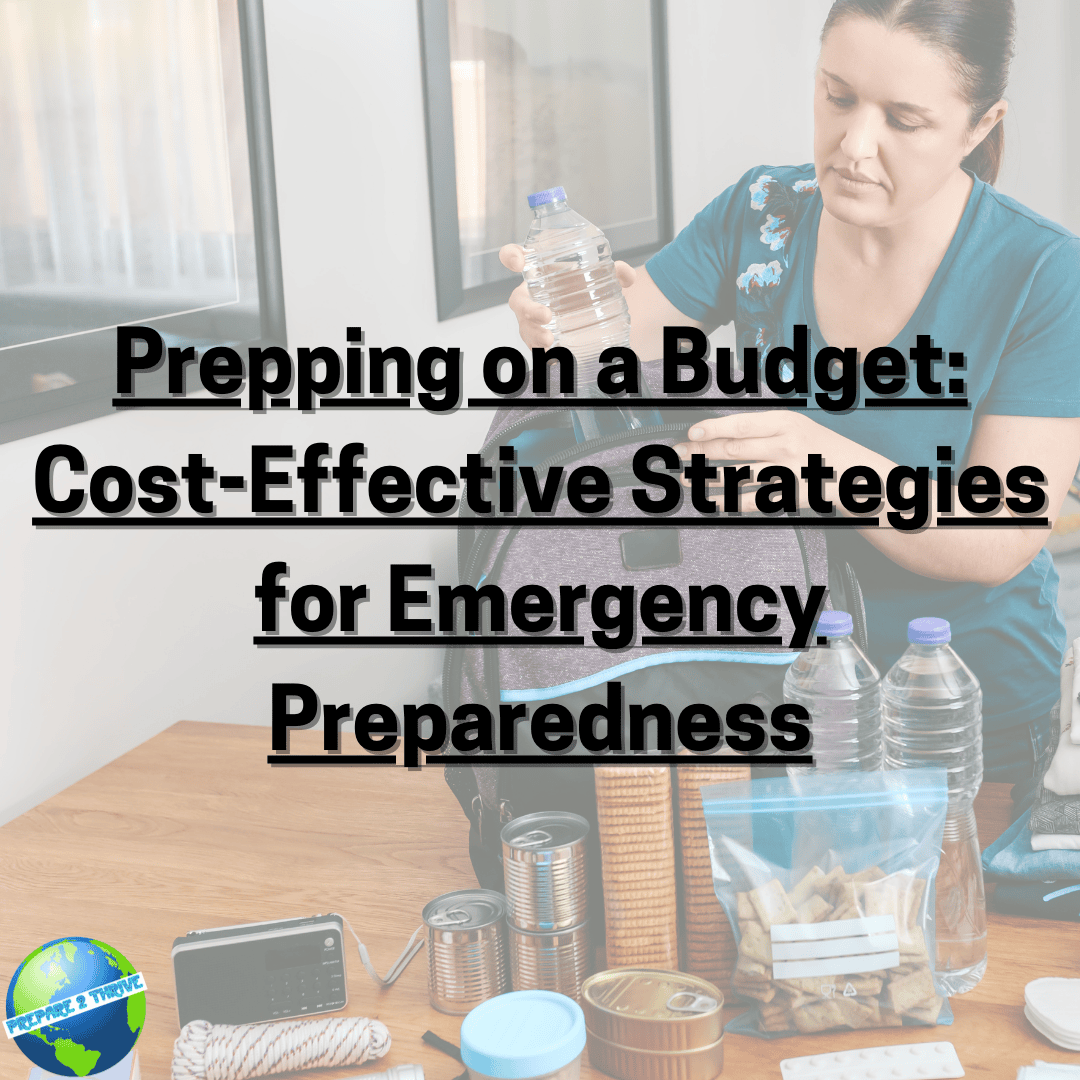I. Introduction
Emergency preparedness is crucial for ensuring the safety and well-being of individuals and communities in times of crisis. Whether it's a natural disaster, a public health emergency, or any unforeseen event, being prepared can make a significant difference in how people cope and recover.
However, there is a common misconception that prepping is an expensive endeavor. Many people believe that emergency preparedness requires a substantial financial investment, which can deter them from taking proactive measures to protect themselves and their loved ones.
In this article, we will debunk this misconception and shed light on cost-effective strategies for prepping on a budget. It's essential to recognize that emergency preparedness is not limited to those with ample financial resources. With careful planning, resourcefulness, and prioritization, anyone can take steps to prepare for emergencies without breaking the bank.
II. Assessing Your Needs and Priorities
Before diving into the process of prepping on a budget, it is crucial to assess your individual needs and priorities. This step allows you to understand what specific supplies and preparations are most important for your situation.
Assessing your needs involves considering various factors such as your location, climate, and personal circumstances. Different regions face different types of emergencies, be it hurricanes, earthquakes, floods, or severe winter storms. Understanding the potential risks and vulnerabilities specific to your area is vital in determining the necessary steps to take.
Take some time to evaluate your living situation, family composition, and any unique requirements. Consider factors like the number of people in your household, any special medical needs, dietary restrictions, and the availability of nearby resources or support systems.
By understanding your needs and priorities, you can make informed decisions about the essential prepping supplies to focus on. It helps avoid overspending on items that may not be necessary for your specific situation and allows you to allocate your budget effectively.
Furthermore, assessing your risks and vulnerabilities empowers you to prioritize your preparations accordingly. For example, if you live in an area prone to power outages, investing in alternative lighting sources and a backup power supply might be a higher priority than other supplies.
Remember that the goal is to be prepared for the most likely scenarios that could impact you and your loved ones. By evaluating your needs and vulnerabilities, you can tailor your prepping efforts to address those specific areas without overspending on unnecessary items.
III. Creating a Budget
When it comes to prepping on a budget, one of the most important steps is creating a budget specifically for your emergency preparedness activities. Setting a budget allows you to allocate funds efficiently and prioritize your spending.
Begin by assessing your current financial situation and determining how much you can realistically afford to allocate for emergency preparedness. Consider your income, monthly expenses, and any existing savings. It's essential to strike a balance between preparing for emergencies and maintaining financial stability.
Once you have an idea of the funds available, allocate a portion of your budget specifically for prepping activities. Treat it as an ongoing expense and make it a priority. By setting aside a dedicated amount, you ensure that funds are consistently available for purchasing necessary supplies and undertaking preparedness measures.
When allocating funds within your budget, focus on the essential prepping expenses first. These may include items such as emergency food and water supplies, first aid kits, basic tools, and necessary medications. Allocate a larger portion of your budget to these critical items before considering additional, non-essential items.
Additionally, consider cost-effective alternatives for certain items. For example, purchasing generic brands or buying in bulk can often save money without compromising on quality. Look for sales, discounts, and second-hand options to stretch your budget further.
Remember that the goal is to be prepared without incurring unnecessary expenses. Prioritize your prepping expenses within the budget based on your assessed needs and potential risks. By doing so, you ensure that you are investing your resources wisely, focusing on what matters most for your specific situation.
Creating a budget for your prepping activities not only helps you manage your finances effectively but also ensures that you can continue prepping on a consistent basis, gradually building your preparedness without breaking the bank.
IV. Building a Stockpile on a Budget
Building a stockpile of essential supplies is a key aspect of emergency preparedness. While it may seem challenging to do so on a budget, there are several cost-effective strategies you can employ to gradually build your stockpile without breaking the bank.
One effective approach is to take advantage of discounts, sales, and coupons. Keep an eye out for sales at your local stores or online retailers that offer discounted prices on prepping items. Look for coupons and promotional codes that can help you save money on your purchases. Joining loyalty programs or newsletters of stores specializing in emergency preparedness can also provide access to exclusive discounts and offers.
Buying in bulk is another cost-saving method when building a stockpile. Purchasing items in larger quantities often results in a lower price per unit. Look for bulk options for non-perishable food items, hygiene products, batteries, and other essential supplies. Just be mindful of expiration dates and rotate your stockpile to ensure items are used before they expire.
Proper storage is essential when building a stockpile on a budget. Invest in sturdy and airtight containers to protect your supplies from moisture, pests, and deterioration. Store your stockpile in a cool, dry place away from direct sunlight. Proper organization and labeling can help you keep track of inventory, prevent waste, and avoid unnecessary duplicate purchases.
Additionally, consider alternative sources for acquiring supplies. Thrift stores, yard sales, and online marketplaces often have prepping items available at significantly lower prices. Keep an eye out for second-hand camping gear, tools, and other equipment that can be useful in emergencies. Just ensure that items are in good condition and meet your quality standards.
Remember that building a stockpile is a gradual process. Start with the essentials and prioritize items based on your assessed needs. Gradually expand your stockpile over time as your budget allows. By employing cost-effective strategies, finding discounts, buying in bulk, and storing items properly, you can build a comprehensive stockpile without straining your finances.
V. DIY and Upcycling Projects
When prepping on a budget, do-it-yourself (DIY) projects can be incredibly valuable. They allow you to create essential prepping items using affordable materials and your own skills. Not only do DIY projects save money, but they also provide a sense of self-reliance and satisfaction.
There are numerous DIY projects you can undertake for essential prepping items. For example, you can make your own emergency kits or go-bags using backpacks or sturdy bags you already have. Fill them with essential supplies such as a first aid kit, flashlight, batteries, non-perishable food, water, and a multi-tool.
Another DIY project is creating your own water filtration system. With some basic knowledge and inexpensive materials like activated charcoal, sand, and gravel, you can build a homemade filter to purify water in emergency situations.
Repurposing and upcycling items also offer cost-effective solutions for prepping. Look around your home for items that can serve dual purposes in emergencies. For instance, empty plastic bottles can be cleaned and used for water storage. Old blankets or clothing can be repurposed as emergency blankets or makeshift bandages.
Get creative with repurposing containers as well. Clean and reuse sturdy jars or cans to store small items like matches, fire-starters, or sewing kits. This not only helps organize your supplies but also reduces waste and saves money on purchasing additional storage containers.
By embracing DIY projects and upcycling, you can save money while customizing prepping items to suit your specific needs. It's important to remember that DIY projects should be based on reliable instructions and proper safety precautions to ensure their effectiveness.
Engaging in DIY and upcycling projects not only adds to your preparedness but also empowers you with valuable skills and resourcefulness. By utilizing readily available materials and your own creativity, you can build a more comprehensive emergency preparedness kit without straining your budget.
VI. Learning Essential Skills
When it comes to emergency preparedness on a budget, acquiring essential skills is invaluable. Building knowledge and proficiency in various areas of self-sufficiency can significantly enhance your ability to navigate and overcome challenging situations.
Acquiring skills is important because even the most well-stocked supplies may become limited or unavailable in certain emergencies. By learning essential skills, you can adapt and find alternative solutions, increasing your resilience and self-reliance.
Here is a list of essential skills that can be learned at low or no cost:
- First Aid and CPR: Basic life-saving techniques can be learned through free online resources, community workshops, or local organizations like the Red Cross.
- Emergency Shelter Building: Understanding how to construct simple shelters using natural materials or basic tools can provide protection and comfort in emergency situations.
- Fire Starting: Learning different methods of fire starting, such as using flint and steel or friction-based techniques, can be acquired through online tutorials or community workshops.
- Water Procurement and Purification: Educate yourself on methods of finding and purifying water sources, such as boiling, chemical treatment, or using water filters.
- Food Preservation and Foraging: Explore resources on food preservation techniques like canning, dehydrating, or fermenting. Additionally, learn about local edible plants and foraging techniques in your area.
- Navigation and Orienteering: Familiarize yourself with using maps, compasses, and celestial navigation to navigate without relying solely on technology.
- Self-Defense and Personal Safety: Seek out free self-defense classes or resources that provide basic techniques and strategies for personal safety in emergency situations.
Community resources can be a valuable asset for learning essential skills on a budget. Local libraries, community centers, or government organizations often offer free or low-cost workshops, seminars, or training sessions on various topics related to emergency preparedness.
In addition, take advantage of free educational materials available online. Numerous websites, YouTube channels, and forums provide a wealth of information on prepping, survival skills, and self-sufficiency. Just ensure that the sources you rely on are reputable and trustworthy.
By investing time and effort in learning essential skills, you gain the ability to adapt, improvise, and overcome challenges in emergency situations. These skills not only complement your preparedness supplies but also provide a foundation for long-term self-sufficiency and resilience.
VII. Networking and Community Collaboration
Networking and collaborating with like-minded individuals can greatly enhance your cost-effective prepping efforts. By forming connections and joining prepping communities or groups, you can leverage shared knowledge, resources, and skills, leading to more efficient and comprehensive emergency preparedness.
There are several advantages to networking with others who share an interest in prepping:
- Shared Knowledge and Experience: Networking allows you to tap into the collective wisdom and experience of others. By exchanging ideas, tips, and strategies, you can learn from each other's successes and challenges.
- Resource Sharing: Collaborating with others enables pooling of resources, reducing individual costs. This can involve sharing bulk purchases, equipment rentals, or even communal storage spaces for stockpiling supplies.
- Skills and Expertise: Networking provides an opportunity to connect with individuals who possess unique skills or expertise that complement your own. By working together, you can leverage each other's strengths and fill knowledge gaps.
- Group Purchasing Power: When individuals come together, they often gain more negotiating power when purchasing supplies in bulk. This can lead to discounts, better prices, or access to exclusive deals.
- Emotional Support and Motivation: Being part of a prepping community provides emotional support and motivation during the often overwhelming process of emergency preparedness. You can share concerns, discuss challenges, and celebrate achievements together.
To form or join prepping communities or groups:
- Attend Local Events: Look for local workshops, seminars, or conferences focused on emergency preparedness. These events are excellent opportunities to meet like-minded individuals and connect with local prepping communities.
- Join Online Forums and Social Media Groups: Participate in online forums, Facebook groups, or other social media platforms dedicated to prepping. Engage in discussions, ask questions, and seek out individuals or groups in your area.
- Host or Attend Meetups: Organize or join meetups with other preppers in your community. These informal gatherings can facilitate networking, knowledge sharing, and building relationships.
- Collaborate on Projects: Engage in collaborative projects with fellow preppers, such as community emergency response drills, group purchases, or organizing workshops or training sessions.
Collaborative efforts within prepping communities can result in significant cost savings and increased preparedness capabilities. By sharing resources, knowledge, and skills, you can maximize the effectiveness of your budget and achieve a higher level of readiness.
Remember that networking and community collaboration should be based on mutual respect, trust, and shared goals. Building strong relationships and maintaining open communication are key to fostering a supportive and effective prepping community.
VIII. Long-Term Sustainability on a Budget
Achieving long-term sustainability is a crucial aspect of prepping on a budget. By incorporating strategies that promote self-sufficiency and reduce reliance on external resources, you can enhance your preparedness in a cost-effective manner.
Here are some tips for achieving long-term sustainability:
- Gardening: Cultivating a home garden is a cost-effective way to produce fresh and nutritious food. Start small and grow vegetables, herbs, or fruits that are well-suited to your climate and available space. Save seeds from your harvest for future planting to reduce ongoing expenses.
- Preserving Food: Learn food preservation techniques such as canning, dehydrating, or fermenting. These methods allow you to extend the shelf life of your garden produce or bulk purchases, minimizing food waste and ensuring a stable food supply during emergencies.
- Raising Small Livestock: Consider raising small livestock, such as chickens for eggs or rabbits for meat. They require less space and resources compared to larger livestock, and can provide a sustainable source of protein. Research local regulations and best practices for raising animals in your area.
- Renewable Energy Sources: Explore renewable energy options to reduce reliance on the grid. Solar panels, wind turbines, or portable solar generators can provide alternative power sources during extended power outages. Look for affordable options and consider starting with smaller-scale systems.
- Water Conservation: Implement water conservation practices to maximize your water supply. Install rainwater collection systems to capture and store rainwater for gardening or other non-potable uses. Use water-saving devices, such as low-flow faucets and showerheads, and collect and reuse greywater whenever possible.
- Skills Development: Continuously acquire new skills that contribute to long-term sustainability. Learn about permaculture principles, composting, natural building techniques, or off-grid cooking methods. These skills not only enhance your self-sufficiency but also have long-term cost-saving benefits.
By focusing on long-term sustainability, you can reduce your reliance on external resources and build resilience in the face of prolonged emergencies or disruptions. These strategies not only help you save money over time but also provide a sense of self-reliance and security.
Remember to prioritize the strategies that are feasible and suitable for your specific circumstances. Start small, gradually expand your efforts, and continue learning and adapting as you progress towards a more sustainable and cost-effective prepping approach.
IX. Evaluating and Adjusting Your Prepping Plan
Regularly evaluating and adjusting your prepping plan is crucial to ensure its effectiveness and cost-efficiency. As circumstances change and new information becomes available, it's important to review your strategies and make necessary adjustments to maintain a well-prepared and budget-conscious approach.
Here are some guidelines for evaluating and adjusting your prepping plan:
- Assess Effectiveness: Evaluate how well your current prepping strategies align with your goals and priorities. Consider factors such as the specific risks in your area, the practicality of your supplies and skills, and any gaps or areas for improvement.
- Review Cost-Efficiency: Take a close look at the expenses associated with your prepping efforts. Consider whether there are more cost-effective alternatives or ways to optimize your budget. Look for opportunities to reduce waste, find budget-friendly alternatives, or share resources with others.
- Stay Informed: Continuously seek updated information about potential risks, emerging technologies, and best practices in emergency preparedness. Subscribe to reputable sources, participate in relevant online forums or social media groups, and stay connected with your local community's emergency management resources.
- Seek Continuous Improvement: Adopt a mindset of continuous improvement and adaptability. Regularly educate yourself, learn new skills, and explore innovative solutions. Experiment with different approaches and techniques to find what works best for you and your budget.
- Involve Family and Community: Engage your family members or close friends in the evaluation and adjustment process. Discuss their perspectives, gather feedback, and ensure everyone is on the same page. Additionally, collaborate with your local prepping community or group to exchange ideas, share experiences, and learn from one another.
Remember, preparedness is an ongoing process rather than a one-time event. By regularly evaluating and adjusting your prepping plan, you can adapt to changing circumstances, optimize your resources, and enhance your overall preparedness.
Be open to learning from both successes and challenges, and be willing to make necessary changes when circumstances warrant it. Flexibility and adaptability are key traits in maintaining an effective and budget-conscious approach to emergency preparedness.
X. Conclusion
In this article, we have explored cost-effective strategies for emergency preparedness, debunking the misconception that prepping has to be expensive. We have highlighted the importance of assessing individual needs and priorities, creating a budget, building a stockpile on a budget, engaging in DIY and upcycling projects, acquiring essential skills, networking with like-minded individuals, focusing on long-term sustainability, and regularly evaluating and adjusting prepping plans.
Remember, prepping can be done on a budget. By prioritizing and being resourceful, you can take meaningful steps towards preparedness without breaking the bank. Here are some key takeaways:
- Assess Your Needs and Priorities: Understand your specific requirements and potential risks to determine essential prepping supplies.
- Create a Budget: Set a budget for your prepping activities and allocate funds accordingly, making sure to prioritize expenses.
- Build a Stockpile on a Budget: Look for cost-effective ways to accumulate essential supplies, utilize discounts and bulk purchasing, and store items properly.
- Embrace DIY and Upcycling: Explore do-it-yourself projects and repurposing items to save money while acquiring necessary prepping items.
- Acquire Essential Skills: Focus on learning low-cost or free skills that contribute to self-sufficiency and preparedness.
- Network and Collaborate: Connect with like-minded individuals, form or join prepping communities, and leverage collaborative efforts for cost-effective prepping.
- Prioritize Long-Term Sustainability: Implement strategies such as gardening, food preservation, raising small livestock, utilizing renewable energy sources, and practicing water conservation.
- Regularly Evaluate and Adjust: Continuously review your prepping plan, assess its effectiveness and cost-efficiency, and adapt as necessary.
We encourage you to take action and start prepping within your means. Even small steps can make a significant difference in your preparedness. Remember, the goal is to be resilient and self-reliant in the face of emergencies or disruptions.
Prepare at your own pace, focus on the essentials, and continually improve your knowledge and skills. By being proactive and resourceful, you can achieve effective emergency preparedness on a budget.
Stay safe, stay prepared!
Hashtags: #PreppingOnABudget #EmergencyPreparedness #CostEffectivePrepping #DIYProjects #Sustainability #BudgetPrepping





